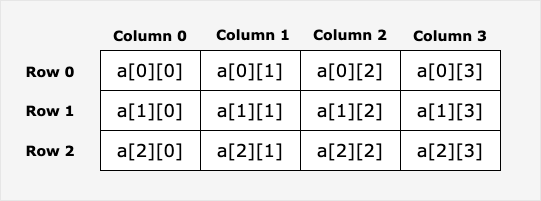Go language multidimensional array
Go language supports multi-dimensional arrays. The following are common declaration methods of multi-dimensional arrays:
var variable_name [SIZE1][SIZE2]...[SIZEN] variable_type
The following example declares a 3D array of integers:
var threedim [5][10][4]int
Two-dimensional array
Two-dimensional array is the simplest multi-dimensional array, and two-dimensional array is essentially composed of one-dimensional array. A two-dimensional array is defined as follows:
var arrayName [ x ][ y ] variable_type
variable_type for Go data type of the language arrayName is the name of the array, the two-dimensional array can be thought of as a table, x is the row and y is the column. The following figure shows that a two-dimensional array a has three rows and four columns:

Elements in a two-dimensional array can be passed through the a[ i ][ j ] to visit.
Example
package main
import "fmt"
func main() {
// Step 1: Create an array
values := [][]int{}
// Step 2: Add two rows of one-dimensional arrays to
an empty two-dimensional array using the append() function
row1 := []int{1, 2, 3}
row2 := []int{4, 5, 6}
values = append(values, row1)
values = append(values, row2)
// Step 3: Display two rows of data
fmt.Println("Row 1")
fmt.Println(values[0])
fmt.Println("Row 2")
fmt.Println(values[1])
// Step 4: Accessing the first element
fmt.Println("The first element is:")
fmt.Println(values[0][0])
}
The output of the above instance is as follows:
Row 1
[1 2 3]
Row 2
[4 5 6]
The first element is:
1
Initialize two-dimensional array
Multidimensional arrays can be initialized by curly braces. The following example is a two-dimensional array of three rows and four columns:
a := [3][4]int{
{0, 1, 2, 3} , /* The first row index is 0 */
{4, 5, 6, 7} , /* The second row has an index of 1 */
{8, 9, 10, 11}, /* The third row has an index of 2 */
}
Note: the penultimate line in the above code }, there must be a comma, because the last line } you can’t have a single line, but it can be written like this:
a := [3][4]int{
{0, 1, 2, 3} , /* The first row index is 0 */
{4, 5, 6, 7} , /* The second row has an index of 1 */
{8, 9, 10, 11}} /* The third row has an index of 2 */
The following example initializes a two-dimensional array of two rows and two columns:
Example
package main
import "fmt"
func main() {
// Create a 2D array
sites := [2][2]string{}
// Adding Elements to a 2D Array
sites[0][0] = "Google"
sites[0][1] = "Runoob"
sites[1][0] = "Taobao"
sites[1][1] = "Weibo"
// Display Results
fmt.Println(sites)
}
The output of the above instance is as follows:
[[Google Runoob] [Taobao Weibo]]
Access two-dimensional array
A two-dimensional array is accessed by specifying coordinates. Such as row and column indexes in an array, for example:
val := a[2][3]
or
var value int = a[2][3]
The above example accesses the fourth element in the third row of the two-dimensional array val.
Two-dimensional arrays can use loop nesting to output elements:
Example
package main
import "fmt"
func main() {
/* Array -5 rows and 2 columns*/
var a = [5][2]int{ {0,0}, {1,2}, {2,4}, {3,6},{4,8}}
var i, j int
/* Output array elements */
for i = 0; i < 5; i++ {
for j = 0; j < 2; j++ {
fmt.Printf("a[%d][%d] = %d\\n", i,j, a[i][j] )
}
}
}
The output of the above instance is as follows:
a[0][0] = 0
a[0][1] = 0
a[1][0] = 1
a[1][1] = 2
a[2][0] = 2
a[2][1] = 4
a[3][0] = 3
a[3][1] = 6
a[4][0] = 4
a[4][1] = 8
The following example creates a multi-dimensional array with a different number of elements in each dimension:
Example
package main
import "fmt"
func main() {
// Create an empty two-dimensional array
animals := [][]string{}
// Create a three-dimensional array with different lengths for each array
row1 := []string{"fish", "shark", "eel"}
row2 := []string{"bird"}
row3 := []string{"lizard", "salamander"}
// Add a one-dimensional array to a two-dimensional array using the
append() function
animals = append(animals, row1)
animals = append(animals, row2)
animals = append(animals, row3)
// Loop output
for i := range animals {
fmt.Printf("Row: %v\\n", i)
fmt.Println(animals[i])
}
}
The output of the above instance is as follows:
Row: 0
[fish shark eel]
Row: 1
[bird]
Row: 2
[lizard salamander]